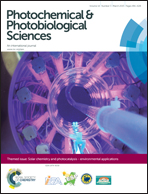Modeling of degradation kinetic and toxicity evaluation of herbicides mixtures in water using the UV/H2O2 process
Abstract
The UV/H2O2 process was applied to the treatment of different mixtures of herbicides in water. Glyphosate, the herbicide most used in the world, was mixed with other hormonal herbicides with residual activity as 2,4-D and dicamba. The main goals of the study were to develop a kinetic model for interpreting the simultaneous oxidation of two mixtures (glyphosate plus 2,4-D and glyphosate plus dicamba). The model is based on a complete reaction mechanism, which comprises hydrogen peroxide photolysis and decomposition of both herbicides in each mixture studied. It takes into account the effect of non-uniform distribution of the local rate of absorbed photons. Good agreement of experimental data and the model is achieved in spite of differences in the reactivity between glyphosate and 2,4-D (or dicamba). Toxicity assays (employing Vibrio fischeri) were also performed, indicating that the toxicity of the mixture of glyphosate and 2,4-D was significantly reduced after the treatment.

- This article is part of the themed collection: Solar Chemistry and Photocatalysis - environmental applications

 Please wait while we load your content...
Please wait while we load your content...